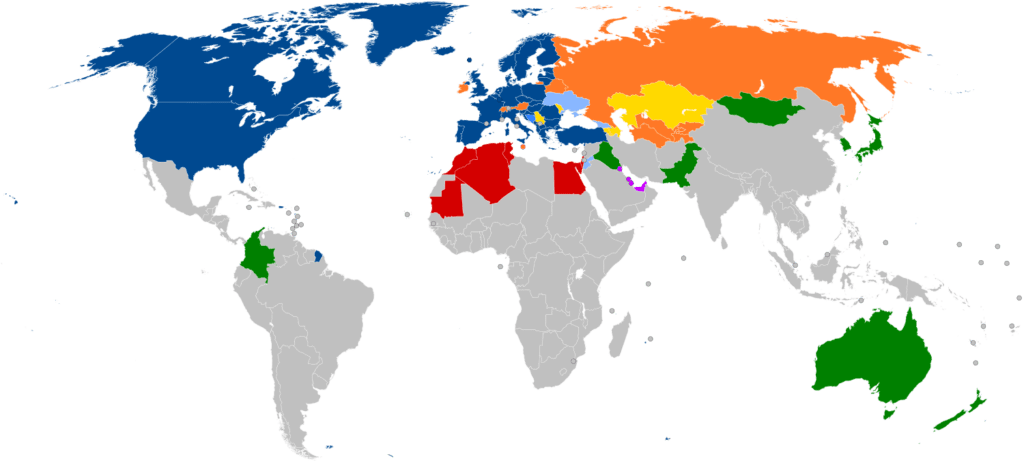North Atlantic Treaty Organization (NATO) is marked their 75th anniversary
North Atlantic Treaty Organization (NATO): The NATO welcome their 75th inauguration day at a special event in Brussels, Belgium. On 4 April 1949, North Atlantic Treaty Organization (NATO) was formed after the World War II, It is the international military alliance of 32 member states—30 European and 2 North American including Albania, Belgium, Bulgaria, Canada, Croatia, Czechia, Denmark, Estonia, Finland, France, Germany, Greece, Hungary, Iceland, Italy, Latvia, Lithuania, Luxembourg, Montenegro, Netherlands, North Macedonia, Norway, Poland, Portugal, Romania, Slovakia, Slovenia, Spain, Sweden, Turkey, United Kingdom, United States.
North Atlantic Treaty Organization (NATO)
NATO member list

All NATO member follows the Article 5 which states that an attack on one member is an attack on all. which was invoked after the 9/11 attacks on the United States in 2001.
Executive Body
The structure of NATO (North Atlantic Treaty Organization) includes several key components which is as follows :
- North Atlantic Council (NAC): The NAC is the principal political decision-making body within NATO. It consists of ambassadors from each member country and meets at least once a week. The council provides guidance and direction on NATO’s political and strategic issues.
- Secretary General: The Secretary General is the head of NATO and serves as the principal spokesperson and representative of the organization. They are responsible for coordinating NATO’s activities, convening meetings of the NAC, and overseeing the implementation of decisions.
- Military Committee: The Military Committee is the highest military authority within NATO. It is composed of the Chiefs of Defence (CHODs) of each member country and advises the NAC on military matters. The Military Committee also provides military guidance to NATO’s strategic commanders.
- International Staff: The International Staff is the civilian arm of NATO and supports the work of the NAC and the Secretary General. It is responsible for providing political, diplomatic, and administrative support to the organization.
- Integrated Military Command Structure: NATO’s military command structure consists of strategic commands responsible for planning and executing military operations. This structure includes Allied Command Operations (ACO), responsible for operational planning and execution, and Allied Command Transformation (ACT), responsible for developing military capabilities and doctrine.
- Military Forces: NATO member countries contribute military forces to support the organization’s collective defense and security efforts. These forces may be deployed for various purposes, including collective defense, crisis management, and cooperative security activities.
| Country | Year Joined |
|---|---|
| Albania | 2009 |
| Belgium | 1949 |
| Bulgaria | 2004 |
| Canada | 1949 |
| Croatia | 2009 |
| Czechia | 1999 |
| Denmark | 1949 |
| Estonia | 2004 |
| Finland | 2023 |
| France | 1949 |
| Germany | 1955 |
| Greece | 1952 |
| Hungary | 1999 |
| Iceland | 1949 |
| Italy | 1949 |
| Latvia | 2004 |
| Lithuania | 2004 |
| Luxembourg | 1949 |
| Montenegro | 2017 |
| Netherlands | 1949 |
| North Macedonia | 2020 |
| Norway | 1949 |
| Poland | 1999 |
| Portugal | 1949 |
| Romania | 2004 |
| Slovakia | 2004 |
| Slovenia | 2004 |
| Spain | 1982 |
| Sweden | 2024 |
| Türkiye | 1952 |
| United Kingdom | 1949 |
| United States | 1949 |
When was NATO was inaugurated?
NATO was inaugurated on 4 April 1949 after the aftermath of World War II
- Marathi Sexy Girl Bike Riding Video: Watch Now
- Germany Faces Recession as Economy Contracts Unexpectedly
- TATA IPL 2023: क्या इस बार मिलेगा आईपीएल को नया चैंपियन , या फिर चैंपियन टीमें ही फिर मारेंगी बाजी
- CTTC Bhubaneswar Recruitment Notification: Various Posts Available
- Uppena fame Krithi Shetty had high hopes for Manamey, after multiple failed movie character



